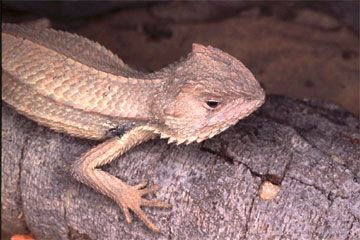
E: Environment, Enrichment,
Education, & Endangered Species
All content © by Diana L. Guerrero unless otherwise noted and may not be reprinted without prior written permission. All rights reserved. Click here for reprint permissions and fees.
Stenocercus quinarius lizard in Brazil (photo by Cristiano Nogueira).
Animals of the Month
Two New Lizard Species Discovered
in Brazil’s Cerrado Region
Stenocercus squarrosus lizard in Serra das Confusões National Park, Brazil (photo by Andre Pessoa).
Two new species of lizard found in Brazil were described in the South American Journal of Herpetology. No more than fourteen centimeters from head to tail, these small creatures resemble miniature dragons according to the scientists who discovered them.
Living primarily near the ground, on tree trunks and small cavities, two new lizards discovered in Brazil's Cerrado Region use their disruptive colors and cryptic behavior as camouflage in the dense and dry savannas. Their scientific names refer to their morphology: quinarius refers to the five well-marked dorsal crests, and squarrosus in reference to the stiff, erected scales of the entire body.
“Time is running out as habitat destruction continues. Future studies on the Stenocercine lizards will provide a much better picture of diversity, as the new species carry unique and very important information on speciation processes that may help to understand the relationships between major blocks of open habitats in South America,” says Brazilian herpetologist Cristiano Nogueira, a biodiversity analyst with Conservation International (CI) and co-author of the paper that first named the two new species.
Recent estimates show that at least 2 million hectares of the Cerrado are destroyed each year. It is estimated that by 2030, only the legally protected areas (now covering less than 3 percent of the region) will remain as original Cerrado habitats.
The two new species are found generally in a special type of dense savanna, locally called “carrasco,” in dry, flat sandstone tabletops. This type of habitat, whose origins are still a puzzle to botanists, harbor a mixture of Cerrado and Caatinga plant species, and is being quickly destroyed by irregular charcoal production and soybean plantations. These habitats may represent ancient vegetation types now restricted to naturally isolated fragments within the surrounding Caatinga and Cerrado.
These are the first new species described as a result of the largest inventory of squamate reptile diversity in the Brazilian Cerrado (one of the 34 biodiversity hotspots named by CI), concluded in 2006 by Nogueira during his doctoral studies at the University of São Paulo.
Discovered in the region of Grande Sertão Veredas National Park, on the tablelands of the Serra Geral plateau, Stenocercus quinarius is relatively safe within the protected area. However, its populations outside the conserved area are under threat due to habitat loss and the expansion of mechanized agriculture, especially in the Cerrado areas of the Bahia state – where CI has been working in the Jalapão-Western Bahia biodiversity corridor.
The situation of Stenocercus squarrosus, discovered during a field research lead by Hussam Zaher, curator of reptiles at MZUSP (University of São Paulo Zoology Museum), also deserves attention. The new species was found only within Serra das Confusões National Park, in the Cerrado and Caatinga contact zone, where CI works in the Uruçuí-Mirador biodiversity corridor. This protected area may be enlarged soon, expanding to pristine tabletops of the Serra Vermelha.
The Cerrado Squamate inventory, funded by FAPESP (the State of São Paulo Research Foundation) and Conservation International (CI), recorded 253 squamate species, 73 more than the 180 previously known for the Cerrado savannas. Of these 253 species, at least 103 are endemic, challenging earlier notions of low vertebrate endemism in the Cerrado hotspot.
About the columnist: Since 1978 Diana L. Guerrero has worked professionally with both wild and domestic animals. Guerrero has been affiliated with, and certified by, a variety of animal programs in the USA and Europe. Based in California, she writes, consults, and speaks. Information on her animal career programs, training courses, and her books {What Animals Can Teach Us about Spirituality (SkyLight Paths, 2003), Blessing of the Animals (Sterling, 2007), Help! My Pet is Driving Me Crazy (Guerrero Ink, 2007), Animal Disaster Preparedness for Pet Owners & Pet Professionals (Guerrero Ink, 2007)} can be found in this web site and in the shop. Questions for Guerrero should be submitted via the blog comments or membership forum.






